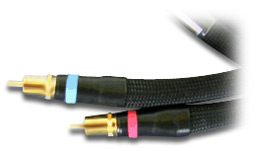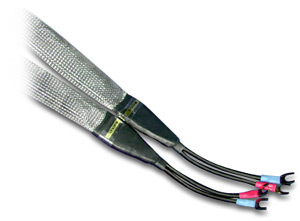![[SoundStage!]](../titles/sslogo3.gif) Home
Audio Home
Audio Equipment Review |
|||||||||||||||||||||||
November 2003 Magnan Type Vi Interconnects and Reference Speaker Cables by Keith Forrest
David Magnan and company have been producing audio cables since 1990 not too far south of where I live in Northern California. I had heard many good things about Magnan cables from several associates in the industry, but I had never had the chance to hear any of the company's products in my system before this review, my first for SoundStage!. In a nutshell, Magnan’s cable philosophy is to use the thinnest conductors possible to reduce skin effect. The Type Vi interconnects use a very thin (5/10,000th of an inch-thick) high-resistivity bronze ribbon conductor. Type Vi interconnects are completely handmade, with a black braided-nylon jacket, and label in gold and blue with directional arrows. The diameter is approximately 3/8'' for single-ended interconnects and 1/2'' balanced. The Type Vi is Magnan’s entry-level interconnect. At $600 and $700 for single-ended and balanced one-meter pairs respectively, these cables may seem a little pricey for entry-level products. However, the Type Vi is squarely aimed at other manufacturers’ reference-level interconnects. Build quality of Type Vi interconnects is as good as I have seen. The conductors of the Magnan Reference speaker cables are very thin copper foil, 0.00075" to be exact, in a stacked-ribbon configuration, one 1 1/4"-wide ribbon per cable run. The termination is interesting: 1 1/2" of each cable is narrowed down to two flexible leads with spade or banana connectors. According to Magnan, this design effectively reduces skin-effect time smear to that of 1/120th of a typical conventional speaker cable. The Magnan Reference speaker cable is basically a miniaturized version of the Magnan Signature speaker cable, the company's top-of-the-line product. The build quality of the Magnan Reference speaker cables is good, but not quite to the same level of the Type Vi interconnects. The ends are thin and seem a bit fragile. This is a cable you will want to take care of while attaching and detaching from amplifiers and speakers. Listening with the Reference speaker cables Overall, I found the Magnan Reference speaker cables to be very enjoyable. I never had a strong urge to change the Magnan Reference cables out due to any sonic flaw I strained to hear. Their sound is slightly on the warm side of neutral, but the Reference speaker cables certainly do not sound dark or rolled off in the least. And when Magnan states that they are aiming at eliminating smearing caused by the skin effect, I think this effort does shine through with the Reference speaker cables, which sound highly focused.
These cables are also able to convey an excellent sense of soundstage depth. "Festival Te Deum" from Chesky’s Ultimate Demonstration Disc [Chesky UD095] displays holographic imaging and tremendous depth. This beautiful choral arrangement is performed in a large church and captured using an omnidirectional microphone mounted some 30 feet in the air. This is one of the finest choral recordings I have heard. The Magnan Reference speaker cables were able to convey the immense volume of the soundstage of the recording. Even though the choir is quite far away from the microphone, the images of the choir and even individual singers come across as naturally placed much lower than the listener -- as if I were sitting on a balcony listening to the heavenly music. No image smearing here! There is also a hiss-like noise on this track that can be easily mistaken on lower-resolution systems as tape background noise or hiss. This noise is in actuality air steadily leaking from the pipes of the accompanying organ. When the organ plays, it envelopes the room, coming from the farthest corners of the soundstage. With the Magnan cables in use, it took very little imagination for me to believe that I was sitting on a balcony listening to this performance live. This is the measure of great audio re-creation. No audio system can absolutely simulate the sound of live acoustic music; however, I have found that certain great recordings on certain well-matched systems can transport me to an event with merely a little suspension of disbelief. This happened here. Some audiophiles may not want to spend $600 on speaker cables. At one point in my life (when I was a poor student), I would have never considered spending such an amount on speaker cables. However, after hearing quite a few high-priced cables in the last several years, I think it's obvious that someone can spend a lot more money than $600 on speaker cables and wind up with a whole lot less than the Magnan Reference speaker cables. At or near their price point, there is no speaker cable I prefer. Type Vi interconnect Magnan's Type Vi interconnect is one of the most resolving I've heard from the lower midrange to the upper treble. Like the Reference speaker cables, the sound of the Magnan Type Vi is focused and accurate. Some interconnects sacrifice accuracy for harmonic fullness, but Magnan Type Vi does not fall into this category. Type Vi presents a soundstage in which the images are the correct size and have appropriate amounts of air and distance between them.
A good example of this is "Painter Song" off Nora Jones' ubiquitous Come Away with Me [Blue Note 5 32088 2]. I have heard Jones’ vocals on this track sound like they are coming from a single pinpoint in space to sounding like they are coming from a large square area. With the Type Vi interconnects, the image was comfortably between these extremes. The Type Vi interconnects are capable of portraying a sense of a singer's chest without going overboard and bloating the image. Many interconnects have a hard time achieving this delicate imaging balance. What I enjoyed most about the Type Vi interconnects is their midrange, which was not overly liquid, as some high-priced interconnects achieve. Instead their midrange was amazingly resolving while being musical and pleasurable at the same time. There is a fine line between resolution and brightness, and I think these Magnan Type Vi interconnects do an excellent job of presenting their resolving midrange without falling into the pitfalls of brightness. The bottom end of these cables, while quite good, was not quite up to the caliber of the midrange and treble. Low bass notes and drumbeats did not have the clarity or quite the speed in relation to other frequency bands. This criticism is not meant to indicate that the lower frequencies of the Magnan cables were unacceptable, but the midrange and higher frequencies of this cable were so transparent and fast that the bass sounded less sublime in comparison. Overall I would say the Type Vi interconnects are great at conveying music. They are able to breathe life into three-dimensional space by conveying realistic images. They have the ability to resolve low-level information through the lower midrange and treble and thereby allow the listener to hear more of the music. Both the Type Vi and the Reference speaker cables offered nicely rendered attack and decay, and both cables are also fast and do not obstruct the pace, timing, and drive in music that gets feet tapping. Compare and contrast I have tried several sets of interconnects in the past three years, including Nordost Quattro Fil, Acoustic Zen Silver Reference, Virtual Dynamics Nite, and Jena Labs Symphony. My personal favorites have been the Jena Labs interconnects and the Magnan Type Vi, with the Virtual Dynamics Nite working well in certain systems. The Type Vi remind me of Nordost Quattro-Fil without the thinness I associate with that interconnect. The Type Vi have the precision of Quattro-Fil along with the ability to present music with harmonic richness and presence closer to that of the Jena Labs Symphony.
Compared to the bass of my reference Jena Labs interconnects, that of the Type Vi was slightly slower and didn't have quite as much control and resolution. But to make this observation, I had to compare the two interconnects back to back several times. It is not an observation that I would classify as obvious. The Jena Labs Symphony has the ability to add a bit more weight and presence to instruments and vocals; however, the Type Vi has a slightly more resolving midrange than the Symphony. The Jena Labs cables cost $500 more a meter than the Magnan Type Vi, and the Quattro-Fil cost even more still. My speaker-cable reference is the Supra Sword, and at around $950 for eight feet, these cables are not only a great value but stunning performers at any price. The Supra Sword speaker cables are the most transparent, resolving, and tonally balanced I have tried. The Swords produce an amazingly coherent soundstage that I have not heard with any other speaker cable short of the Nordost Valhalla. At one and a half times the price of the Magnan Reference, the Supra Sword could be considered an unfair rival. I was mistaken. After I switched out the Supra Sword for the Magnan Reference speaker cables, my system’s sound did not change nearly as much as when I inserted the Magnan digital cable (see my sidebar). In fact, I was surprised at how little the sound changed with the Magnan speaker cables. The only quality I remotely missed with the Magnan Reference Speaker cables was ultimate low-end control and resolution. In nearly every other aspect the Magnan cable acquitted itself nicely when compared to the Supra Sword. There seems to be definite diminishing returns comparing the Sword to the Reference, however. Yes, the Sword is ultimately a touch more resolving and has a slightly more stable soundstage and a bit more instrumental and vocal presence. But I am talking about inches here, not miles. It would be interesting to compare the Supra Sword to Magnan’s Signature speaker cables, which are closer to each other in price. Conclusions I was impressed with the sound I was able to obtain from my reference system using Magnan Type Vi interconnects and Reference speaker cables. My speakers, the Vienna Acoustic Mahlers, with two 10" woofers per speaker, have a bottom end that is difficult to control, but the Magnan cables were able to do an admirable job controlling the entire bass range. Although most of my criticisms of the Reference speaker cables and the Type Vi interconnect involve bass control, these are minor issues, and frankly most observations took changing the cables out back to back. Besides, music happens most in the midrange, and the Magnan midrange is wonderful. The Magnan cables did an outstanding job of being both musical and transparent -- to a point that I would recommend them to anyone in the market for cables at their price points and beyond. Are they the ultimate cables? The Reference speaker cables and Type Vi interconnects are Magnan’s entry-level offerings. Magnan makes other interconnects and speaker cables that I imagine offer greater resolution, instrumental presence, and bass control -- at a price, of course. After I heard these Magnan cables, I immediately contacted the company and asked about the differences between the Reference and Type Vi and the company's other cables. I figured that if Magnan can get the kind of kind of stellar performance I noted from their lowest-priced offerings, I wanted to hear their very best products. Such is the curiosity of an audiophile. ...Keith Forrest
|
|||||||||||||||||||||||
|
|||||||||||||||||||||||
![[SoundStage!]](../titles/sslogo3.gif) All
Contents All
ContentsCopyright © 2003 SoundStage! All Rights Reserved |

